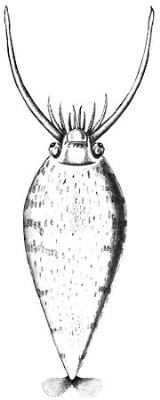
Helicocranchia pfefferi
Encyclopedia
The Banded Piglet Squid (Helicocranchia pfefferi) is a small squid
of the genus Helicocranchia
. Adults of this species are mesopelaegic.
length (ML). The body consists of a large funnel
with small paddle-like fins. They have small tentacle
s above their eyes. The funnel does not have valves but contains a dorsal pad with three papillae as organs. Paddle-shaped fins are attached to a part of the gladius. H. pfefferi has a single ocular photophore
and does not have photophores at its arm
tips.
e (<30 mm ML), they live near the surface of the oceans, between 100 m and 200 m deep. They descend to the mesopelagic zone as they mature, but do not exhibit a diel vertical migration
pattern.
Squid
Squid are cephalopods of the order Teuthida, which comprises around 300 species. Like all other cephalopods, squid have a distinct head, bilateral symmetry, a mantle, and arms. Squid, like cuttlefish, have eight arms arranged in pairs and two, usually longer, tentacles...
of the genus Helicocranchia
Helicocranchia
Helicocranchia is a genus of glass squids.-External links:*...
. Adults of this species are mesopelaegic.
Physical characteristics
The average size of adult H. pfefferi is 100 mm in mantleMantle (mollusc)
The mantle is a significant part of the anatomy of molluscs: it is the dorsal body wall which covers the visceral mass and usually protrudes in the form of flaps well beyond the visceral mass itself.In many, but by no means all, species of molluscs, the epidermis of the mantle secretes...
length (ML). The body consists of a large funnel
Hyponome
A siphon is an anatomical structure which is part of the body of aquatic molluscs in three classes: Gastropoda, Bivalvia and Cephalopoda. In other words, a siphon is found in some saltwater and freshwater snails, in some clams, and in octopus, squid and relatives.Siphons in molluscs are tube-like...
with small paddle-like fins. They have small tentacle
Tentacle
A tentacle or bothrium is one of usually two or more elongated flexible organs present in animals, especially invertebrates. The term may also refer to the hairs of the leaves of some insectivorous plants. Usually, tentacles are used for feeding, feeling and grasping. Anatomically, they work like...
s above their eyes. The funnel does not have valves but contains a dorsal pad with three papillae as organs. Paddle-shaped fins are attached to a part of the gladius. H. pfefferi has a single ocular photophore
Photophore
A photophore is a light-emitting organ which appears as luminous spots on various marine animals, including fish and cephalopods. The organ can be simple, or as complex as the human eye; equipped with lenses, shutters, color filters and reflectors...
and does not have photophores at its arm
Cephalopod arm
A cephalopod arm is distinct from a tentacle, though the terms are often used interchangeably.Generally, cephalopod arms have suckers along most of their length, as opposed to tentacles, which have suckers only near their ends. Octopuses have eight arms and no tentacles, while squid and cuttlefish...
tips.
Habitat
As paralarvaParalarva
Paralarvae is the term used to describe the young planktonic stages of cephalopods, between hatchling and subadult. It is used to differentiate it from the term 'larva' used in animals which undergo true metamorphosis. They have been observed only on members of the orders Octopoda and Teuthida.The...
e (<30 mm ML), they live near the surface of the oceans, between 100 m and 200 m deep. They descend to the mesopelagic zone as they mature, but do not exhibit a diel vertical migration
Diel vertical migration
Diel vertical migration, also known as diurnal vertical migration, is a pattern of movement that some organisms living in the ocean and in lakes undertake each day. Usually organisms move up to the epipelagic zone at night and return to the mesopelagic zone of the oceans or to the hypolimnion zone...
pattern.

